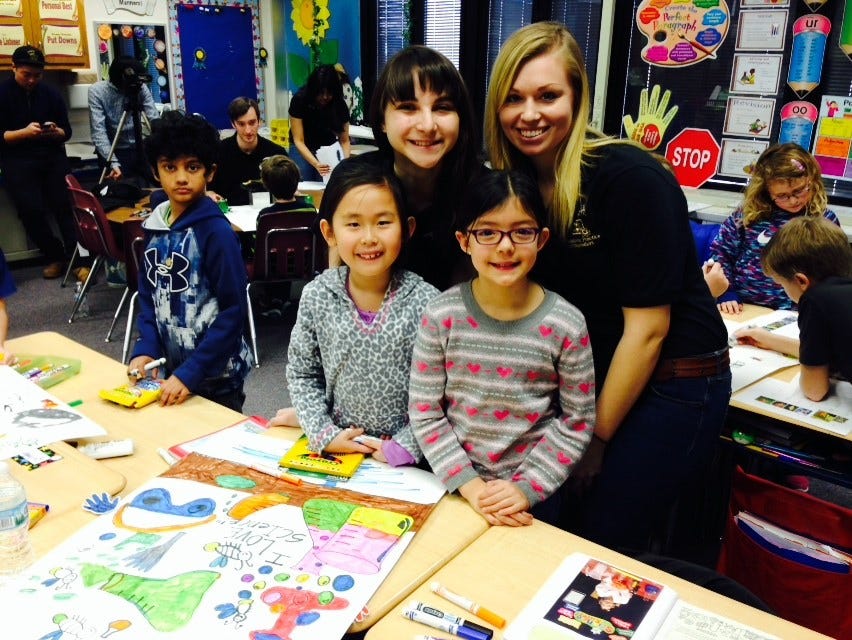Second Graders Blast Lightning Bug Research to Space
 Purdue aerospace engineering undergrads are helping the second graders design the experiment for space.
Purdue aerospace engineering undergrads are helping the second graders design the experiment for space.
Subscriber Benefit
As a subscriber you can listen to articles at work, in the car, or while you work out. Subscribe NowCan fireflies light up in outer space? It’s a question that likely only a child would think to ask. The answer would require a rocket ship—and that’s exactly what a class of second grade students in West Lafayette will be using. Unlike any other end-of-year project, the students are now finalizing their firefly experiment, which will be ready for liftoff in just a matter of months. With Purdue University undergraduates as co-pilots, Cumberland Elementary School will be among the first elementary schools in the U.S. to conduct science in space.
In a universe-themed classroom, it’s not surprising Maggie Samudio’s students think out of this world. When the unusual firefly question surfaced during a classroom discussion, Samudio e-mailed Purdue Professor of Aeronautics and Astronautics Dr. Steven Collicott for the answer.
Collicott’s response: let’s rent a rocket and find out. He contacted the Arete-STEM Foundation, an organization established by a retired elementary school teacher to enable schools to launch payloads onboard commercial rockets for about $3,000.
“Three-thousand dollars for a space flight experiment is accessible to just about every school in the country; that’s far less than a set of football uniforms,” says Collicott. “I’m not staying stop playing football, but schools all over the country spend this money—much more than this—because parents and local businesses think it’s worthwhile.”
The project is generating donations, and Samudio’s classroom experiment is scheduled to launch in the fall after working on it throughout this school year.
Because they can’t send real fireflies to space, the second graders had to learn about the chemistry that makes a firefly light up: the chemicals luciferin and luciferase combine with oxygen to trigger the glow. Collicott says the experiment will replicate the firefly chemistry in space, “so it comes down to, will the chemistry function in weightlessness?”
The answer will be revealed inside a four-inch cube, which is the size requirement for sending research to space. Six Purdue aerospace engineering undergrads are guiding the second graders through the experiment design process.
“[My second graders] think it’s amazing that they can work with Purdue students who are engineers. When an adult of that caliber comes into the classroom, it’s like a rock star has walked through the door,” says Samudio. “Three of the Purdue students are female; what great role models for the girls. They may think, ‘Look, they’re engineers. I can be an engineer.’ That interaction is so inspiring to the children.”
Collicott, who has taught the Zero Gravity Flight Experiment class at Purdue for 20 years, says his students quickly uncovered their first design challenge: the experiment has to be loaded on the rocket two days before launch. One of the chemicals isn’t shelf stable, so they had to design a system that would inject water into a powder version of the chemical.
A signal from the spacecraft’s computer system will trigger the luciferin and luciferase to mix once the rocket reaches sub-orbital space. A tiny camera mounted inside the cube will record the entire experiment and return to Earth with video answering the students’ question: did the chemicals glow?
“It’s been very good for the Purdue students to have to explain things on that [elementary] level—things about the hardware, the function of it and the chemistry,” says Collicott. “It really helps you understand what you’re doing when you have to explain it to an 8 year-old.”
Regardless of glow or no-glow, Samudio says the experiment is already a success, illuminating 20 little minds at Cumberland Elementary.
“It’s causing them to dream. You never know what kind of seed is going to be planted in a child,” says Samudio. “The sky’s the limit.”
And even that barrier will soon be broken.
Samudio says the project is making her students more inquisitive and hungry readers.
Collicott says the answer will be revealed by replicating—in space—the chemistry that makes fireflies glow.
Collicott says the project is an opportunity “to get a lot of good teaching done.”
